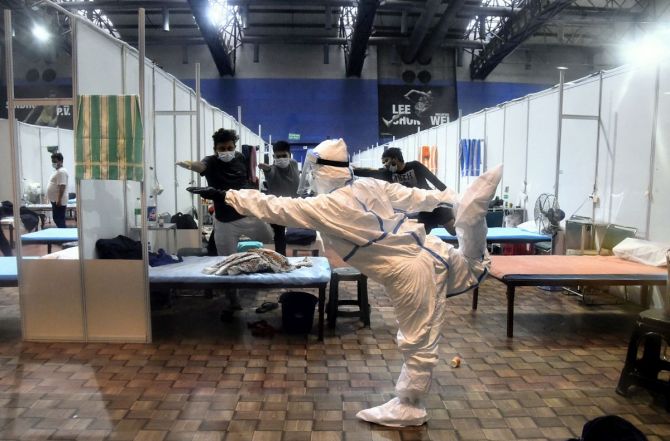'You could have an additional pool of 15,000-odd qualified and competent doctors.'

The Manipal Group has roughly 3,000 beds in its teaching hospitals. With its acquisition of Columbia Asia recently, it has added more than 3,500 regular hospital beds across 27 hospitals.
"When we closed down the country, perhaps we failed to ramp up our home care and out-of-hospital facilities and instead focussed on large hospitals. Then people would have had access in this wave to a reasonable level of care outside the big hospitals -- and not just in the metros," Manipal Education and Medical Group CEO S Vaitheeswaran tells Anjuli Bhargava.
What can be done immediately to augment the supply of doctors and healthcare professionals to tackle the pandemic?
There are almost 300 medical colleges in the country with doctors who don't practise but mainly teach. Many of them can be roped in to treat or tele-consult, and you could have an additional pool of 15,000-odd qualified and competent doctors.
A lot of people are asymptomatic or have mild symptoms that can be managed with a doctor's guidance at home. We are exploring this for our own pool of teaching and treating doctors.
We also have a fairly large pool of army doctors from the Armed Forces Medical College, senior defence doctors, and nurses, who may have retired but are in good health. I'd expect almost 2,500-4,000 of them. They can be deployed almost immediately. Many of them can give even six to eight hours a day to attend to patients.
But this needs the Centre and states to think on their feet, coordinate and set the protocols in place.
What have you as a group done in this space for this national emergency?
Sixty-five to 70 per cent of our total bed capacity has been diverted to Covid care. Other elective care, routine surgeries and medical procedures are being delayed wherever possible.
We have made use of our teaching doctors as well. An average 2,500 RT-PCR tests are being done every day across facilities. Over 100 off-facility vaccination camps have been held in Bengaluru over the last few months.
We have activated homecare units to help those, who need attention but not hospitalisation, in cities where we have Manipal or Columbia Asia hospitals. We are trying to set up a formal tele-consulting system with our 4,000-odd doctors advising patients for two-four hours a day. This is city-agnostic and can help reduce the panic, too.
We are also pitching in a bigger way with government efforts, whenever asked. It is important that the government is not too prescriptive on this front. If a non-Covid patient requires treatment, the discretion must be left to the doctor and not to some regulator sitting far away.
When we closed down the country, perhaps we failed to ramp up our home care and out-of-hospital facilities and instead focussed on large hospitals. Then people would have had access in this wave to a reasonable level of care outside the big hospitals -- and not just in the metros. I think we missed the boat.
The pandemic may have sharply highlighted the gap, but why is there a shortage of doctors even in the normal course of things?
There is a shortage of doctors, nurses and technicians even in normal times. We have 1.3 to 1.5 doctors for every 1,000 people. Medical seats available in India are around 80,000 whereas the aspirants are 1.5 million.
Let me talk of the supply side. Setting up a medical school of 150 students requires a 750-bed hospital (every seat needs five teaching hospital beds). If we don't include land, the cost of setting up a 150-bed teaching facility would range between Rs 150 crore and Rs 200 crore (Rs 1.5 billion to Rs 2 billion). Raising money to set up such facilities is not easy since higher education is not for profit in India.
There are elaborate procedures and regulations to be complied with, and it can take years. Qualified teachers are not easy to find and government prescribed requirements for specialisations and sub-specialisations lead to onerous faculty numbers that are often tough to meet.
Let me highlight the positives, too. We have just set up a medical school in Jamshedpur with the Tatas -- Manipal-Tata Medical College -- in two years, and we had the full support of the Jharkhand government, which gave us quick approvals. At full capacity, the facility will produce 250 doctors a year.
But one needs 50 such instances in the country at least for the next 10 years to bridge the gap.
Based on your experience in other countries, what can India do to augment its supply of doctors and other healthcare staff?
Becoming an MD in the US requires a student to meet many criteria but there is another category of professionals who fill in and assist the senior physicians -- precision assistants. These courses are strongly focussed on anatomy, biology and internal medicine. In two years, they become certified physician assistants who work with doctors and earn upwards of $150,000 a year.
We could look at something like this in India as well. It is a pity that the old family doctor practice is all but vanishing. Few need specialised care. Mostly, people need care for basic ailments. So everybody need not be an MBBS or specialise in some discipline.
If you want to increase the supply chain, you need to widen the funnel, not restrict it.











